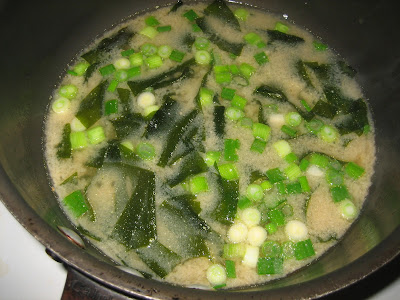"My father and I taught those two. Even if these two are out of the dojo, their misuse of the blade is my responsibility. I thought I was trying hard to teach Katsujen-Ken. Swordsmanship to benefit people.
I guess it was just an illusion."
Book: Rurouni Kenshin by Nobuhiro Watsuki
Recipes: The Complete Book of Japanese Cooking by Emi Kazuko
Recipes: The Complete Book of Japanese Cooking by Emi Kazuko
Buta-Niku Shoga Yaki
(Pan-Fried Pork with Ginger Sauce)
1 lb pork loin
1 small onion, thinly sliced lengthwise
1/4 cup beansprouts, if you can find them
2 oz snow peas (or green beans because you can't find snow peas either)
1 tbsp vegetable oil
For the marinade:
1 tbsp shoyu
1 tbsp mirin
1 tbsp sake
1 1/2 in piece of ginger, peeled and grated
Wrap the pork in plastic wrap and freeze for 2 hours. With a sharp knife cut into 1/8 in slices. Or you can skip this step because you want to eat before midnight, try to slice it using the butterfly method, get frustrated and give up, and watch as your boyfriend does it beautifully each time (Thank you, Jay!). Slice the thin meat into 1 1/2 wide strips.
Mix all the marinade ingredients and add the pork for 15 minutes.
Heat the oil in a pan over medium high heat and add the onions. Saute for 3 minutes. Add half the pork to the onions and saute until the color of the meat just turns (I hate overcooked pork) remove the meat and keep warm while you saute the second half. Add the second half of the meat, and all the onions to the plate and keep warm.
Pour the reserved marinade into the pan and cook until the sauce is reduced by one third. add the beansprouts and snow peas and cook until tender, then return the pork and onions and cook for another 2 minutes. Serve the slices of meat alternating with the snow peas, leaned up against a pile of beansprouts on each plate.
Basically, this recipe just barely escaped being a disaster. The flavors were superb, even without the beansprouts and the green bean substitution. The problem was the timing on the meat. The recipe says to cook it for three full minutes. I cooked it even less than that, but when I added it back into the marinade, it was a bit overcooked. Also, I didn't think about the fact that green beans take a lot longer to cook than pea pods, so I just threw them in the pan. We ended up having to remove the meat and keep it warm, and continue cooking the beans, but by that time, all the sauce had cooked off and was scorching on the bottom. Our beans, slightly too crisp, were just barely saved from tasting burnt. Next time, if snow peas are scarce, I would steam the beans a bit first, then toss them in with the meat at the very last second.
Miso Soup
A small portion of dried wakame (seaweed)
One pack of silken tofu, cut into cubes
1 2/3 cup of dashi stock (dried bonito tuna stock, or dashi bullion)
3 tbsp white miso
2 scallions, chopped
Soak the wakame in a bowl of cold, salted water for 15 minutes (thank you Yan for the tip on salting! it really does keep the wakame from turning slimy) .
Cut the tofu into bite sized strips.
Bring the broth to a boil. Remove from heat and mix a portion of the broth with the miso in a bowl. Return the miso mixture the pan. Keep the heat on low, but do not allow the broth to boil. Add the tofu and scallions, and wakame, and serve.
I could not find tofu at either of the grocery stores I usually shop in. The first time I made this recipe, I couldn't find Dashi No-Moto either (Dashi Bullion). I substituted half the amount of vegetable bullion, which, as predicted, was a tad too salty. I also took the recipe at its word when it said that I should use 5 grams of dried Wakame, half the package, and ended up with enough Wakame to feed miso soup to an army of hungry, rebellious samurai for a week. Nonetheless, the soup was good.
When I made it the second time, I had the actual Dashi stock and was a bit surprised to learn its origin. It's a soup base that's made from boiling dried, shaved flakes of bonito tuna (note to all my strict veg friends, this might be up there with the revelation that Worcestershire sauce has anchovies in it!). The second time around, I also had an appropriate cluster of wakame, and chopped button mushrooms to take the place of the tofu, and that soup was even better.
About the book: Apparently, the samurai have sunken so low as to be deemed drunks, bullies, and braggarts. At least the former students of Kaoru's school for swordsmen have. And naturally, those they chose to bully are a gang of "derelicts" who are worse than the Yakuza. When Kaoru says that she will accept the shame of her former students, the thugs are not shy of fighting a woman. Of course, they don't have to because Himura Kenshin arrives in time to blast them out the dojo!
One thing I do like about this book is that it has a lot of interesting historical notes; for instance, did you know that Japan had wooden cannons that fired clay cannon balls? According to the book, they could do as much damage as a steel cannon. Of course, this does nothing to help the thugs, because Himura is one tough rurouni.




No comments:
Post a Comment